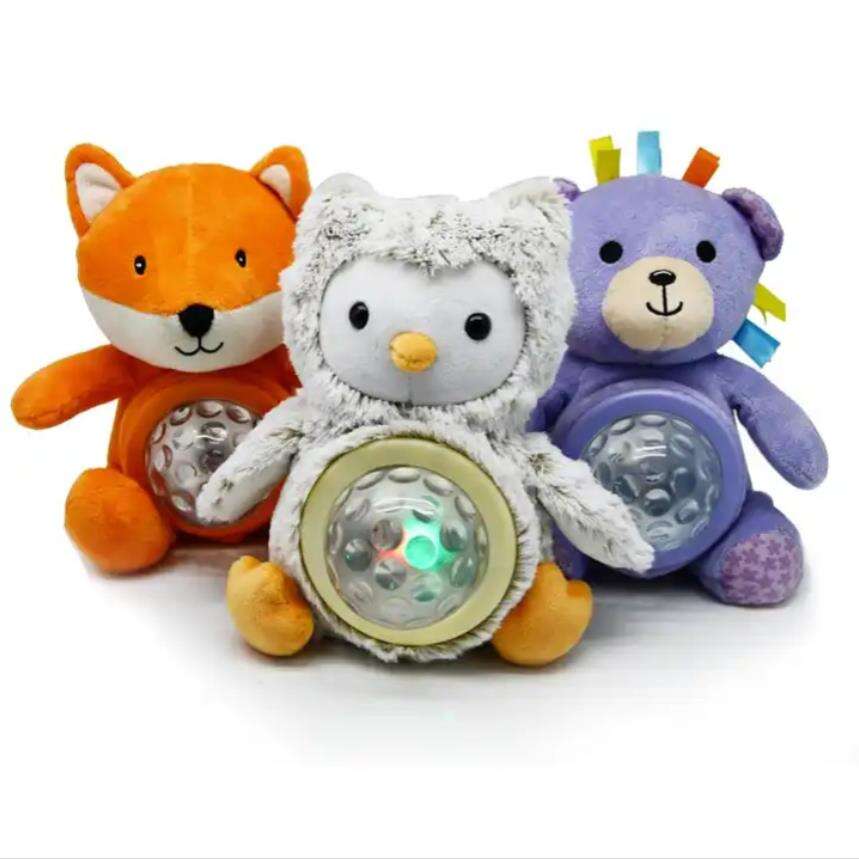Finger Puppets: Affordable and Interactive Toys for Preschool Education
Why Finger Puppets Shine in Early Education
Affordability Meets Educational Value
One of the standout features of finger puppets is their affordability while providing substantial educational value. Finger puppets allow educators to integrate a cost-effective tool into their teaching arsenal. Their low cost doesn't compromise the rich educational benefits they bring, making them a valuable asset in early childhood education. Research highlights the positive effects of puppet-based learning on children's cognitive and social development, offering significant returns on investment for educational institutions. This allows educators to access diverse stories and characters without stretching budgets, facilitating enriched learning experiences that captivate and educate young minds. For educators keen to optimize their resources, finger puppets present an ideal solution, blending economical pricing with robust educational outcomes.
Versatility Across Learning Environments
Finger puppets are remarkably versatile, capable of being used in a wide range of educational settings, from traditional classrooms to home environments and community centers. This adaptability makes them an indispensable resource for encouraging creativity and learning across multiple contexts. Whether it's a structured lesson in literacy or an unstructured play session focused on problem-solving, finger puppets integrate seamlessly across various subjects, including science and social studies. Their lightweight and portable nature further enhances their utility, allowing educators to easily carry them and incorporate them into spontaneous lessons. This flexibility ensures that finger puppets are not just tools for planned educational activities but are also potent in seizing teachable moments, thus empowering teachers to create dynamic and engaging experiences for students.
Essential Skills Developed Through Puppet Play
Cultivating Creativity and Imagination
Engaging with finger puppets fosters creativity and allows children to explore their imagination by creating unique narratives. The process of inventing dialogues and scenarios through puppet play enhances imaginative play and is linked to cognitive development. Experts in play therapy advocate for puppet play as it nurtures creative skills, encouraging children to think outside the box. Furthermore, creative engagement through puppetry offers opportunities for problem-solving and exploring diverse perspectives, contributing to overall cognitive growth.
Strengthening Fine Motor Abilities
Manipulating finger puppets is an excellent way for children to develop fine motor skills, which are crucial for activities like writing and self-care. Occupational therapists recommend puppet play for enhancing dexterity and hand-eye coordination. These skills are vital for young learners as they prepare for more complex tasks. Additionally, incorporating games and drills using puppets into daily routines can systematically strengthen these motor capabilities, making puppet play not only enjoyable but also beneficial.
Advancing Language Acquisition
Puppet play creates a language-rich environment that facilitates vocabulary expansion and improves verbal skills. Through interactive storytelling and role-playing, children engage in dialogue, which enhances comprehension and retention of language concepts. Studies have shown that puppet-based storytelling aids preschoolers in understanding complex language structures. By practicing conversational skills with finger puppets, children can playfully express themselves, reducing anxiety often associated with verbal communication.
Building Social-Emotional Intelligence
Engaging in puppet play offers children a safe avenue to express emotions and understand social cues, fostering empathy and emotional literacy. Puppets serve as vessels for exploring difficult emotions and scenarios, thus providing a platform for discussing feelings. Social learning theorists recognize puppetry's role in teaching conflict resolution and cooperative play skills among peers. By acting out various situations, children learn to identify and empathize with emotions, enhancing their social-emotional learning.
Practical Applications for Preschool Settings
Finger puppets offer a versatile and engaging tool for enhancing preschool learning experiences. They can make interactive storytelling sessions more vivid and captivating, helping to capture children's attention and stimulate their imagination. By integrating puppets into storytime, educators can encourage children to participate actively, retell stories, and improve their comprehension skills. Through puppet performances, kids can also engage deeply with narratives, reenacting them and consequently reinforcing their understanding of story structure.
Interactive Storytelling Sessions
Utilizing finger puppets during storytelling sessions can enhance narrative engagement, making stories more vivid for young children. These puppets provide a dynamic way to capture children's attention, stimulating their imagination as they interact with the story. Teachers can encourage active participation by integrating puppets into storytime and asking children to contribute to retelling the stories. This interaction not only heightens engagement but also builds comprehension, allowing children to deepen their narrative understanding by reenacting favorite tales. By doing so, preschool educators can create an interactive and imaginative learning environment that fosters literacy and comprehension skills.
Collaborative Role-Play Activities
Finger puppets serve as an excellent medium for collaborative role-play activities in preschool settings, facilitating teamwork and communication among young learners. As children enact different scenarios and roles, they develop social skills by practicing real-life situations in a controlled environment. Educators can design themed role-play activities using puppets, integrating moral lessons or real-world experiences. This method offers a constructive approach to fostering social skills, encouraging children to work together and communicate effectively through engaging and immersive play sessions.
Special Needs Adaptations
Finger puppets are valuable tools for inclusive learning environments, particularly in special needs education. Their versatile nature allows for tailored strategies catering to diverse learning requirements. Puppets can greatly assist non-verbal children by providing a means of expression, fostering communication, and promoting social interactions in a fun and engaging manner. Special educators often use puppets in behavioral therapy to create scenarios that encourage emotional regulation and the development of coping strategies. In this way, puppets can support a broad range of learning needs, enabling a more inclusive and adaptive educational experience.
Maximizing Puppet Potential: Teacher Tips
Selecting Durable, Safe Materials
The choice of finger puppets hinges significantly on the quality and safety standards of the materials. To ensure safety and longevity, teachers should prioritize investing in puppets made with durable, non-toxic materials, which are essential for safe classroom environments. Trusted guidelines, such as those from the American Academy of Pediatrics, underscore the importance of avoiding toys with harmful chemicals to prevent any adverse health effects on children. By choosing high-quality puppets, teachers not only contribute to children's safety but also enjoy the long-term benefit of reducing replacement costs due to wear and tear.
Encouraging Student-Led Play
Empowering students to lead puppet play activities can be an excellent way to nurture their creativity and personal growth. When children take charge of puppet activities, it encourages them to express their ideas vividly, bolstering their confidence and decision-making abilities—key elements of childhood development. By allowing autonomy in such play, educators foster a learning environment where children feel responsible for their educational journey. This sense of ownership can significantly contribute to their engagement and enthusiasm for learning.
Connecting Puppets to Curriculum Goals
Integrating puppet play with curriculum objectives is a dynamic method to ensure that educational goals are achieved engagingly and interactively. Educators can link puppet-themed activities with various subjects, such as math, arts, and sciences, exemplifying a cross-disciplinary learning approach. By meticulously planning these activities, teachers can align them with educational standards and benchmarks, ensuring that students receive a holistic educational experience. This seamless integration enhances both the enjoyment and effectiveness of learning, as children relate subjects to real-world experiences through playful interaction with puppets.
Recommended Products
Hot News
-
Selecting the Right Educational Toys for Different Age Groups
2024-11-08
-
Materials Used in the Production of Stuffed Animals
2024-11-04
-
Chinese Plush Toy Factories Lead the Global Market with Innovation and Quality
2024-01-23
-
How Plush Toys Can Boost Your Mental Health and Well-Being
2024-01-23
-
Plush Toys Factory Industry Trends: A Growing Market with Challenges and Opportunities
2024-01-23
-
Plush Toys Market Demand on the Rise
2024-01-23
-
Woodfield Website Online
2024-01-22

 EN
EN
 AR
AR
 BG
BG
 HR
HR
 DA
DA
 NL
NL
 FI
FI
 FR
FR
 DE
DE
 EL
EL
 IT
IT
 JA
JA
 KO
KO
 NO
NO
 PT
PT
 RO
RO
 RU
RU
 ES
ES
 SV
SV
 TL
TL
 IW
IW
 ID
ID
 SR
SR
 UK
UK
 HU
HU
 MT
MT
 TH
TH
 TR
TR
 FA
FA
 MS
MS
 GA
GA
 IS
IS
 EU
EU
 BN
BN
 LO
LO
 LA
LA
 SO
SO
 KK
KK

